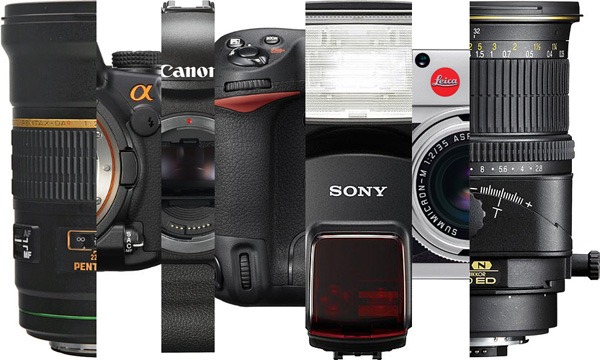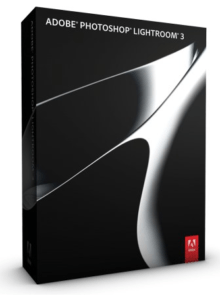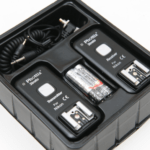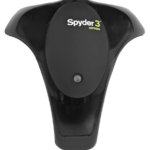
I regularly get asked for recommendations on what gear people should start out with, use, and upgrade to, so I thought that this year I'd put together a list for the holidays. Because who doesn't love photography gifts?
Here's my list of recommendations if you're looking for those best of gifts: photography equipment.
As always, any purchases you make through my affiliate links helps support www.ishootshows.com and bring you features, reviews, and photo tips. In addition, if you want to buy me a cup of tea, feel free to donate via the link in the sidebar!
Photo Software
 Adobe Lightroom 3 – $150
Adobe Lightroom 3 – $150
I use Adobe Lightroom 3 for just about all my photo processing needs. It's essential to my image processing workflow. While the first and second editions never quite satisfied my needs for a RAW processor, the new camera profiles in Lightroom 3 have laid to rest for me any concerns about the quality of the files this program is capable of delivering.
With Lightroom, I'm able to import files, tag, and organize huge numbers of images, as well as apply batch processing to quickly and easily process images. In fact, the retouching & processing tools in Lightroom are so good that I very rarely even open Photoshop anymore for the majority of my work. Furthermore, plugins for PhotoShelter, Flickr, and Facebook make uploading the images a breeze once they're ready to go. Plus, there are plugins for services like Tumblr and other social sharing sites that make Lightroom integrate seamlessly with almost any workflow.
Photo Mechanic – $150
Photo Mechanic is an image browser that I started using halfway through 2011, but it's quickly become an indispensable part of my post-capture workflow.
Like Lightroom, Photo Mechanic allows one to browse a catalogue of images and make ratings, as well as to apply metadata and other basic image adjustments. This core feature overlaps with Adobe Lightroom in many ways. However, what really sets Photo Mechanic apart from the competition is the speed.
It's simply the fastest way to edit photos.
Even working with 14-bit RAW files, the image display for full-resolution images is blazingly quick. It's so much faster than Adobe Lightroom that I only use that I've switched to Photo Mechanic for editing and use Lightroom exclusively for processing RAW files now. Flying through images from a photo shoot and quickly tagging them for an edit has never been faster for me than it is with Photo Mechanic.
Since the program pulls in the embedded JPG file as the preview, instead of trying to render a new one (like Lightroom does), the efficiency of Photo Mechanic is amazing. With Photo Mechanic, I can literally do an edit 2-5 times as quickly as I could with Lightroom.
Photo Websites & Services
PhotoShelter is a professional photo service that I use for my image hosting, print fulfillment, online storage, and archiving. For me, the beauty of PhotoShelter is that it lives up to the digital dream of a one-upload workflow.
After uploading the final high-resolution file to PhotoShelter, I can FTP it to publications, allow private proofing by clients, offer prints for sale, and link to web-sized versions that I post to my blog. No more sending files in very direction every time I need a different end-use – In short, it makes a digital workflow just about as painless as it can be. For any photographer, PhotoShelter is a tool that can help you grow, reach new clients, and simplify your workflow.
Graph Paper Press is a company that makes great WordPress themes for photographers. In fact, I dare say that they offer some of the very best WP themes out there for anyone. Better yet, GPP and PhotoShelter have great integration, so it's simple to customize a site and build in immediate access to your archives for clients and print sales. GPP is what I personally use to power www.ishootshows.com. Read my recommendations for some of their best themes for photographers.
What's more, sign up for Graph Paper Press for 25% off – on me – with this code: 4E7AAA3F34
Cameras
The Big Guns
If you're looking to pull the trigger on a DSLR like the Nikon D7000, Nikon D3s, Canon 5D Mark II, or Canon 7D, or big fat lenses, I suggest heading over to my Gear Guide for a detailed list of the equipment that I regularly use. Or, feel free to hit me up in the comments and I will be happy to give you some buying advice.
Panasonic LX-5 – $370
 The Panasonic LX-5 is a professional's P&S camera – a serious compact, if you will. While it's not as small as the little Canon S95 or as fully-featured as the beefy Canon G12, in my opinion the LX-5 strikes the perfect balance between pro features, great quality, and pocketablility. In fact, I prefer it the interface and form factor to the more expensive Fuji x10 as well.
The Panasonic LX-5 is a professional's P&S camera – a serious compact, if you will. While it's not as small as the little Canon S95 or as fully-featured as the beefy Canon G12, in my opinion the LX-5 strikes the perfect balance between pro features, great quality, and pocketablility. In fact, I prefer it the interface and form factor to the more expensive Fuji x10 as well.
I personally have the Panasonic LX-3 and it's a fantastic little camera when I don't want to lug around a full-sized DSLR. The LX-5 takes all the goodness from its predecessor and adds an improved sensor, a more useful 24-90mm range, and improved ergonomics and control with a jog wheel.
Photo Accessories
 Black Rapid RS-7 Camera Strap – $60
Black Rapid RS-7 Camera Strap – $60
Whenever I'm not using the Double Strap, I use a single Black Rapid strap. For me, the beauty of this strap is that you can wear it multiple ways – sling it across your body or just throw it over your shoulder, you're good to go, ready to shoot. However, what I like best about the Rapid Strap system is that the straps connect to your camera's tripod mount instead of the lugs on top.
While shooting, this translates into a huge benefit, since the strap is completely out of the way on the bottom of the camera. When you're not shooting, the camera simply hangs down out of the way, instead of having to balance from two points of connection as with a conventional camera strap.
Think Tank Airport International v2.0 Rolling Camera Case – $350
The Airport International v2.0 is a rolling camera case that I have personally used every time I've flown for a photo job over the past year. Not only does fit a ton of gear, it fits effortlessly in every single overhead bin that I've encountered, including smaller commuter planes with just 3 seats across a row. It glides through airports and busy streets alike, and it's build like, well, a tank. In short, this bag is almost perfect.
While I normally load my Airport International to the brim with photo gear, the modular compartments of this case mean that it's very easy to also configure it to include just a couple pieces of photo gear while using the rest of the space for clothing. Perfect for photo-loving travelers.
If you buy through this link to Think Tank, you'll also get to select a second bag for free on me.
When in doubt, faster and larger capacity memory cards are always appreciated. This is particularly true as flash memory have continued to expand in capacity and speed, all while dropping in price.
I use both SanDisk Extreme Pro and Transcend Extreme Plus compact flash cards. Both feature basically identical specs of 600x (90mb/sec) write speeds and UDMA-6 compatibility for extremely fast transfers.
For all intents and purposes, these have performed identically. If you're looking for the best, I can highly recommend the SanDisk Extreme Pro cards – if you're looking to save a little cash but still get great performance, the Transcend Extreme Plus cards are a great buy. I've been using the 16gb models of both these cards – 16gb is a huge amount of space on my Nikon D3 and D700.
Flash Accessories
 Phottix Strato II Wireless Flash Trigger – $95
Phottix Strato II Wireless Flash Trigger – $95
One of my current favorites for flash triggers is the Phottix Strato II, which improves on the Phottix Strato wireless flash trigger in a few very useful ways. Just like the original Strato, the Strato II is a trigger designed with a hotshoe to work perfectly with small speedlight flashes – no need for extra PC-sync cables (though there are connectivity options for that, too). The big change with this new trigger is the inclusion of the ability to group flashes and then easily toggle groups on and off from the transmitter. Really nice for quickly setting and adjusting lights on-location to achieve different looks.
You can read my extensive review of the Phottix Strato II over at FlashRAW.com
Lenses
Fast 50mm prime
In my opinion, every shooter shoot have at least one fast prime. If you shoot a full-frame camera like a Canon 5D Mark II or Nikon D700, either the Canon 50mm f/1.4 or the Nikon 50mm f/1.4, respectively, are great choices. I prefer the extra speed of these f/1.4 lenses over the cheaper f/1.8 lenses, as well as their improved performance at wide apertures and the better build quality over the slower models.
For anyone shooting an APS camera, I recommend a lens like the Nikon 35mm f/1.8 or Canon 35mm f/2, which will give a perspective close to the classic 50mm range for 35mm.
Color Balancing & Calibration

Spyder 3 Express Monitor Calibrator – $66
For any serious photographer, a calibrated monitor is a must – otherwise, it's impossible to make accurate and meaningful color correction. I personally use the Spyder 3 Pro, but that's only because I work on two monitors. For a single monitor, the Spyder 3 Express offers all the same features.
The process to use the Spyder 3 is super simple – you position the sensor on the monitor, let the included software run a series of diagnostics, and then a custom monitor profile is created and set to the default for your computer. In short, you get to sit back and wait to experience that joyful experience of having a beautifully calibrated monitor with true color and optimized contrast.
The Spyder Cube is a neat little accessory – it basically packs every tool you need for accurate white balancing into a tiny cube you can slip into your bag. With different faces for white, gray, shadow, specular, and absolute black points, this is a really useful accessory for any photographer that will fit into any camera bag.
In addition to use as a white balance aid, you can use the Spyder Cube as an exposure guide as well, thanks to the specific values of the gray faces.
My brother Chris bought this for me last year – it makes WB a snap.
General Awesomeness
Apple defined the tablet market with the introduction of the original iPad, and the iPad 2 builds on that success with arguably the very best tablet experience to date. For photographers, this means a beautiful 9.7″ screen that's fantastic for showing off photos. Whether it's used as a display for clients, friends or family, images look great on the iPad 2.
Plus, with Apple's own iPad Camera Connection, you can load and edit on the go with the iPad, making it an ultra-light device for image review in the field.
Wacom Intuos Tablet – $199
I use a Wacom Intuos 4 tablet every day – not just for photo editing, but for pretty much anything that involves moving a cursor around a screen. If you do photo editing that requires precision of any kind, the Wacom Intuos is priceless. For me, the benefits of using a Wacom tablet are increased precision and decreased wrist strain/fatigue, both of which translate into much faster edits.
The Intuos tables come in three sizes – small, medium, and large. I personally use the medium tablet, which has a working area of 5.5″ x 8.8″, but even the small tablet offers plenty of room. There's also a wireless Intuos 4 tablet in the medium size if you want to go all out.
 4Sevens Quark AA Flashlight – $57
4Sevens Quark AA Flashlight – $57
A bright, dependable flashlight is something that any photographer can use in their camera bag. To this end, the Quark AA by 4Sevens fits the bill perfectly. This tiny torch uses just a single AA battery (the Eneloops that your speedlights use work perfectly) and puts out a huge amount of light – it puts your big D-cell Maglite to shame.
Plus, the Quark AA features an ultra-low mode of just 0.2 lumens, which is amazingly helpful for maintaining night vision while still having enough task lighting at close range. I keep my Quark AA in my camera bag and it's indispensable at shows if I need to search for something in a dark music venue.
I'd also recommend the awesome Nitecore Defender Infinity, except that Nitecore has discontinued that great light.
If this site has helped you rock out just a little harder, you can help support this site by purchasing your photo equipment through the links above, below, or through product links anywhere else on ishootshows.com.
 |
  |
  |
I freely share what I can through photography tutorials, my gear guide, and the shooting notes I include in every show write-up and band promo I post. Every time you buy gear through these links, it helps me bring you more features, tutorials, reviews, and photo advice. It helps me bring you the rock show.
And if you do pick up some new gear, let me know – I’d love to hear what you got!
Also, if someone else is picking up your holiday goodies, please send them a link to this page or a link to my Support Page if you want your gift to help me out!
If you want to donate directly and keep me stocked in tea, you can contribute money to www.ishootshows.com via PayPal.







